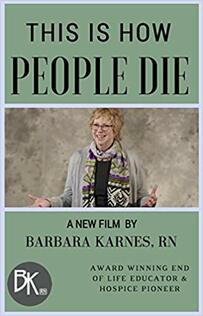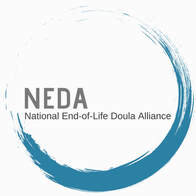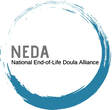 Watch a brief video explaining the premises in this article to help doulas understand the issues around providing after death care (click on the image)
Watch a brief video explaining the premises in this article to help doulas understand the issues around providing after death care (click on the image)
Caution Dead Ahead: After-Death Care and the End-of-Life Doula
by Lee Webster
It’s exciting to see the exponential growth of end of life practice, something we in the home funeral movement tried to imagine years ago when we took up this work. Now, just as we envisioned, families are increasingly seeking to change the way they meet the challenges inherent in planning for and managing the death of a family member, and they are looking for guidance and support in fresh ways that span both the dying and funeral periods.
But what we learned then that holds true even more today is that death is the great divide, at least as far as systems go. Some end-of-life care practitioners train for both pre-death and post-death, with an intention of meeting families’ needs with a seamless home-based continuum of care, a philosophy we have cultivated and supported wholeheartedly. But there is a problem that needs to be addressed, and quickly, and it falls to end-of-life doulas and their trainers to fully understand. Read more...
by Lee Webster
It’s exciting to see the exponential growth of end of life practice, something we in the home funeral movement tried to imagine years ago when we took up this work. Now, just as we envisioned, families are increasingly seeking to change the way they meet the challenges inherent in planning for and managing the death of a family member, and they are looking for guidance and support in fresh ways that span both the dying and funeral periods.
But what we learned then that holds true even more today is that death is the great divide, at least as far as systems go. Some end-of-life care practitioners train for both pre-death and post-death, with an intention of meeting families’ needs with a seamless home-based continuum of care, a philosophy we have cultivated and supported wholeheartedly. But there is a problem that needs to be addressed, and quickly, and it falls to end-of-life doulas and their trainers to fully understand. Read more...

The End-Of-Life Doula Movement
by Barbara Karnes, RN
I started as a hospice nurse in 1981 after spending several years trying to learn how to care for people who were dying. There just wasn't any material about end of life. People generally died in the hospital, in a private room at the end of the hall, alone. No one was there, no one saw how death came. If and when a person was in their home, dying with family present, the family brought their own fears and misconceptions about death and generally just had "horror" stories to tell about what happened when Dad died. Hospice was the "new kid" on the block saying, "We can support, comfort, and guide people and their families as the end of life approaches. No one needs to be alone anymore during this life moment."
It was from my experience being a hospice nurse, whose goal was to be with the patient and family during the months, weeks, days, hours, and then at the moment of death, that I began to actually learn about how people die.
Read more...
by Barbara Karnes, RN
I started as a hospice nurse in 1981 after spending several years trying to learn how to care for people who were dying. There just wasn't any material about end of life. People generally died in the hospital, in a private room at the end of the hall, alone. No one was there, no one saw how death came. If and when a person was in their home, dying with family present, the family brought their own fears and misconceptions about death and generally just had "horror" stories to tell about what happened when Dad died. Hospice was the "new kid" on the block saying, "We can support, comfort, and guide people and their families as the end of life approaches. No one needs to be alone anymore during this life moment."
It was from my experience being a hospice nurse, whose goal was to be with the patient and family during the months, weeks, days, hours, and then at the moment of death, that I began to actually learn about how people die.
Read more...
 Courtesy of Amanda Carr
Courtesy of Amanda Carr
At The Ready: How End-of-Life Doulas Can Support Hospices
by Lee Webster with Merilynne Rush, Suzanne O'Brien, Patty Burgess, and Deanna Cochran
Anyone who has experienced care of a dying loved one can probably recall a moment when the prospect seemed overwhelming. Sometimes this is small things—wondering when to squeeze in a quick trip to the store, or to simply take a shower. Other times it is much bigger. Am I doing the right thing? Are we tending to what’s important or just getting by? How can I balance all my roles as caregiver, mate, parent, worker, partner?
Imagine being the patient who may be grappling with fears of all sorts—fear of being in pain, being a burden, being unable or afraid to express needs that go beyond those being met by medical personnel. Or the patient who wishes for a conscious, intentional experience, who seeks companionship and guidance on the journey. To them, and to all of us, it becomes not just about the fact that we die, but how that matters. Read more...
by Lee Webster with Merilynne Rush, Suzanne O'Brien, Patty Burgess, and Deanna Cochran
Anyone who has experienced care of a dying loved one can probably recall a moment when the prospect seemed overwhelming. Sometimes this is small things—wondering when to squeeze in a quick trip to the store, or to simply take a shower. Other times it is much bigger. Am I doing the right thing? Are we tending to what’s important or just getting by? How can I balance all my roles as caregiver, mate, parent, worker, partner?
Imagine being the patient who may be grappling with fears of all sorts—fear of being in pain, being a burden, being unable or afraid to express needs that go beyond those being met by medical personnel. Or the patient who wishes for a conscious, intentional experience, who seeks companionship and guidance on the journey. To them, and to all of us, it becomes not just about the fact that we die, but how that matters. Read more...

NEDA Proficiency Assessment: A Micro-Credential
by Merilynne Rush, MSHP, RN, BSN
The NEDA Proficiency Assessment, for which one earns a Proficiency Badge, is a digital micro-credential that provides evidence of achieving a certain level of knowledge. It is based on a set of core competencies that was developed by end-of life doulas and trainers from a variety of organizations. Some individual organizations offer a more comprehensive credential or certification that also assesses skills (see below). EOLDs may want to consider pursuing both. To earn the Proficiency Badge, one must be a member of NEDA and agree to abide by the NEDA Standards of Practice (Scope of Practice and Code of Ethics) for EOLDs.
The NEDA Proficiency Assessment was developed to lend consistency to the definition of what an EOLD is and does, and to provide a degree of assurance to organization and families that use or refer to EOLDs. Read more...
by Merilynne Rush, MSHP, RN, BSN
The NEDA Proficiency Assessment, for which one earns a Proficiency Badge, is a digital micro-credential that provides evidence of achieving a certain level of knowledge. It is based on a set of core competencies that was developed by end-of life doulas and trainers from a variety of organizations. Some individual organizations offer a more comprehensive credential or certification that also assesses skills (see below). EOLDs may want to consider pursuing both. To earn the Proficiency Badge, one must be a member of NEDA and agree to abide by the NEDA Standards of Practice (Scope of Practice and Code of Ethics) for EOLDs.
The NEDA Proficiency Assessment was developed to lend consistency to the definition of what an EOLD is and does, and to provide a degree of assurance to organization and families that use or refer to EOLDs. Read more...
|
NATIONAL END-OF-LIFE DOULA ALLIANCE (NEDA)
2423 SOUTH ORANGE AVE #115 ORLANDO, FL 32806 NEDA is a nonprofit 501c6 membership organization dedicated to supporting end-of-life doulas and the families they serve. Content on this website is for informational purposes only and is not offered as legal advice. |

